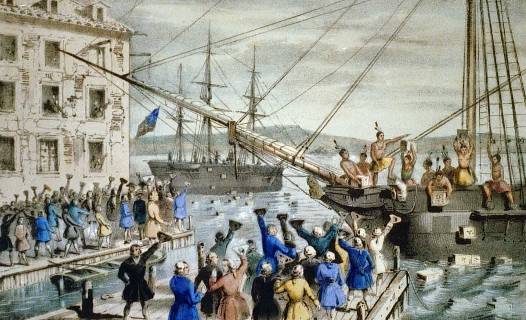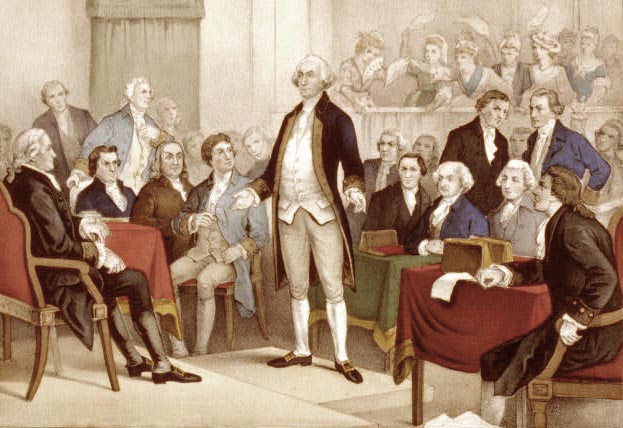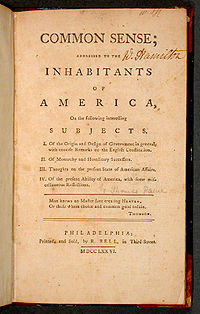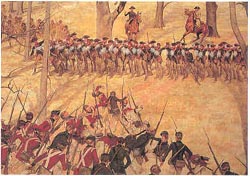Causes of the American Revolution
Stamp Act

The Stamp Act put a tax on all paper and written documents for the British to go out of debt from the 7 years war. The colonists didn’t like this because in their own words they called it “Taxation without representation.”
Townshend acts
The Townshend Acts imposed duties on glass, lead, paints, paper and tea imported into the colonies. Many Americans viewed the taxation as an abuse of power, so they agreed to limit the power and only have a tax on tea.
Boston Massacre

A squad of British Soldiers were on the streets when they misheard an order and killed 5 innocents. The British officer in charge, Capt. Thomas Preston, was arrested for manslaughter, along with eight of his men.
Tea act and Boston Tea Party

The Tea Act put a tax on tea and monopolized an East Indian Tea company. The Boston Tea Party was a protest on the high tax of tea. The Boston Tea Party knocked crates of tea into the sea worth a fortune.
Intolerable Acts

The Intolerable Acts were a series of acts meant to punish the colonists for the Boston Tea Party. This included shutting off the Boston Port which alone could cost the colony a huge amount of money.
First Continental Congress

Twelve of the Thirteen colonies met up to discuss the Intolerable Acts and what they could do to it. They failed to change them so following the next year they met up again to discuss the civil war.
Components of the Civil War
Battle of Lexington
Tensions had been building between residents of the thirteen colonies and the British authorities. British soldiers were sent to destroy a stash of artillery. Paul Revere and others sounded the alarm while colonial militiamen began to take action. They met up and the British retreated.
Battle of Bunker Hill
The Battle of Bunker Hill was lost by the colonists and defeated by the British. They suffered many causalities but this battle gave them more confidence. The Battle of Bunker Hill was mostly fought near Breed’s hill.
Thomas Paine’s Common Sense

Thomas argues independence with his common sense. The argument gives many examples of how the British’s government is broken, sinful, not even protecting the colonists, and don’t respect the colonists.
Declaration of Independence

The Declaration of Independence, written by Thomas Jefferson, states why the colonists sought out independence. In the Declaration of Independence he states that every man is made equal and that there are certain unalienable rights that governments should never violate. It gives many more examples of how the British Government is corrupt and all things were their fault.
Battle of Trenton

General George Washington’s army traveled over 10 days to win 2 crucial battles.In the Battle of Trenton, Washington killed a garrison of Hessian mercenaries before withdrawing. A week later he returned to Trenton and executed a night march to capture Princeton. These victory’s greatly improved the morale and unity of the colonial army and militias.
Battle of Saratoga
This battle was the turning point of the American Revolution. A British General named John Burgoyne won a small, but costly victory over the colonists led by Horatio Gates and Benedict Arnold. Some days later Burgoyne was attacked again and lost, forcing him to retreat. 10 days later he surrendered. This victory helped the French government join the colonists as an ally.
Battle of Camden
The Battle of Camden was a victory for the British, British forces under Lieutenant General Charles, Lord Cornwallis routed the American forces of Major General Horatio Gates. Gates never held a field command again after this.
Battle of the Cowpens

In the battle of Cowpens, american soldiers led by Brigadier General Daniel Morgan routed british soldiers led by Lieutenant Colonel Banastre Tarleton. The americans suffered heavy losses and this was a turning point in the revolutionary war.
Battle of Guilford Courthouse
Although British troops under Lieutenant General Charles Cornwallis achieved a victory at Guilford Courthouse, the British suffered significant troop losses during the battle.
Battle of Yorktown

In the Battle of Yorktown, General George Washington commanded 17,000 French and Continental troops against British General Lord Charles Cornwallis and a contingent of 9,000 British troops at Yorktown, Virginia, in the most important battle of the Revolutionary War.
Consequences of the Civil War
Treaty of Paris

The Treaty of Paris ended the American revolution and recognized independence. The Continental Congress named a five-member commission to negotiate a treaty–John Adams, Benjamin Franklin, John Jay, Thomas Jefferson, and Henry Laurens. Laurens was captured in the Tower of London until the end of the war, and Jefferson did not take part of the negotiations. Instead they were conducted by Adams, Franklin, and Jay.
Loyalists

Loyalists were American colonists that stayed loyal to the British crown after the revolution. They were opposed to the Patriots that supported the revolution.
Constitution
The constitution established the government, laws and guaranteed certain unalienable rights to all citizens. It also limited government power.
Bill of rights
The Bill of Rights was the collective name for the ten amendments the constitution gave. The ten amendments gave rights to citizens and gave specifics about law.
World influence

Benjamin Franklin was much more than just a patriot. At a time when people rarely traveled more than 20 miles from where they were born, Franklin made eight Atlantic crossings and visited ten countries.

![LexGreen8[1]](https://myriverside.sd43.bc.ca/alanv2015/files/2016/03/LexGreen81-273b9ma-300x215.jpg)

![4298[1]](https://myriverside.sd43.bc.ca/alanv2015/files/2016/03/42981-1ljhieg-300x219.gif)
![trenton-map-l[1]](https://myriverside.sd43.bc.ca/alanv2015/files/2016/03/trenton-map-l1-2imjing-300x212.jpg)
![map2[1]](https://myriverside.sd43.bc.ca/alanv2015/files/2016/03/map21-289d374-211x300.gif)



